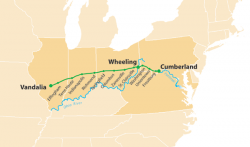
The National Road was the first interstate highway in the United States, and the first roadway to be financed with federal money. Authorized by Congress during the administration of Thomas Jefferson in 1806, the road was built over time and in sections from Cumberland, Maryland, westward through the states of Pennsylvania, Virginia (now West Virginia), Ohio, and Indiana, before terminating at the state capital of Vidalia, Illinois.
At the height of the National Road's utility during the 1830s and 1840s, it was said to have been busy well into the early evening with traffic dominated by passenger and mail stagecoaches - which could travel 60 or 70 miles in a day - and brightly painted Conestoga wagons - made for carrying heavy loads at a speed of 15 miles a day. The coming of railroad travel in the 1850s soon eclipsed the National Road, and individual states eventually took control of the roadway. With the popularity of the autmobile in the 1920s, however, the National Road found new life as U.S. Route 40, an east-west artery crossing the United States.
Facts
- The National Road initially followed a path first blazed by a Delaware Chief named Nemacolin, who had been hired by the Ohio Company, and later expanded into a mililary road by both George Washington and the British General Edward Braddock.
- Twenty feet wide and occupying a 66-foot right-of-way, the National Road was built in layers 12 to 18 inches deep, with larger stones on the bottom, smaller ones on top, and gravel and soil covering the surface -- according to a method devised by the Scottish engineer John Macadam and referred to as "macadamization."
- The first U.S. highway was extremely successful in helping to populate the western territories of a young and growing country. Between 1820 and 1840, for example, the population of the state of Indiana quadrupled, with the majority of new residents arriving on the National Road.
- Prior to the building of the road, President Jefferson's Secretary of the Treasury, Albert Gallatin, reported to Congress that the most efficient way to ship goods from Pittsburgh to Philadelphia -- separated by only 280 miles -- was by way of the Monongahela River in Ohio to the Mississippi River, around the tip of Florida and up the Atlantic coast, a journey of more than 3,000 miles.
- Only a few remnants of the National Road exist today. Some of the bridges built to carry the roadway are still in use, including Dunlap's Creek Bridge, along with nearly 50 structures once used as inns or taverns, some of which operate today as restaurants or bed and breakfasts. Also surviving are two toll houses now part of the National Road Heritage Park in Pennsylvania.
Resources
- Archer B. Hulbert, Old National Road: A Chapter of American Expansion ; Arthur W. McGraw, 1991, ISBN 1566510163
- Karl Raitz, ed., A Guide to the National Road ; Johns Hopkins University Press, 1996, ISBN 0801851564
- Karl Raitz, ed., The National Road , Vol 1; Johns Hopkins University Press, 1996, ISBN 0801851556
- Merritt Ierley, Traveling the National Road: Across the Centuries on America's First Highway ; Overlook Press, 1990, ISBN 0879513942
- Reed B. Day, The Cumberland Road: A History of the National Road ; Closson Press, 1997, ISBN 1558562273



- Harper's Magazine, 1879